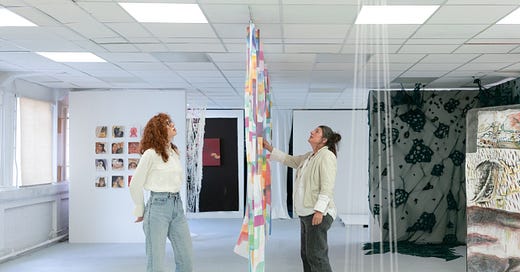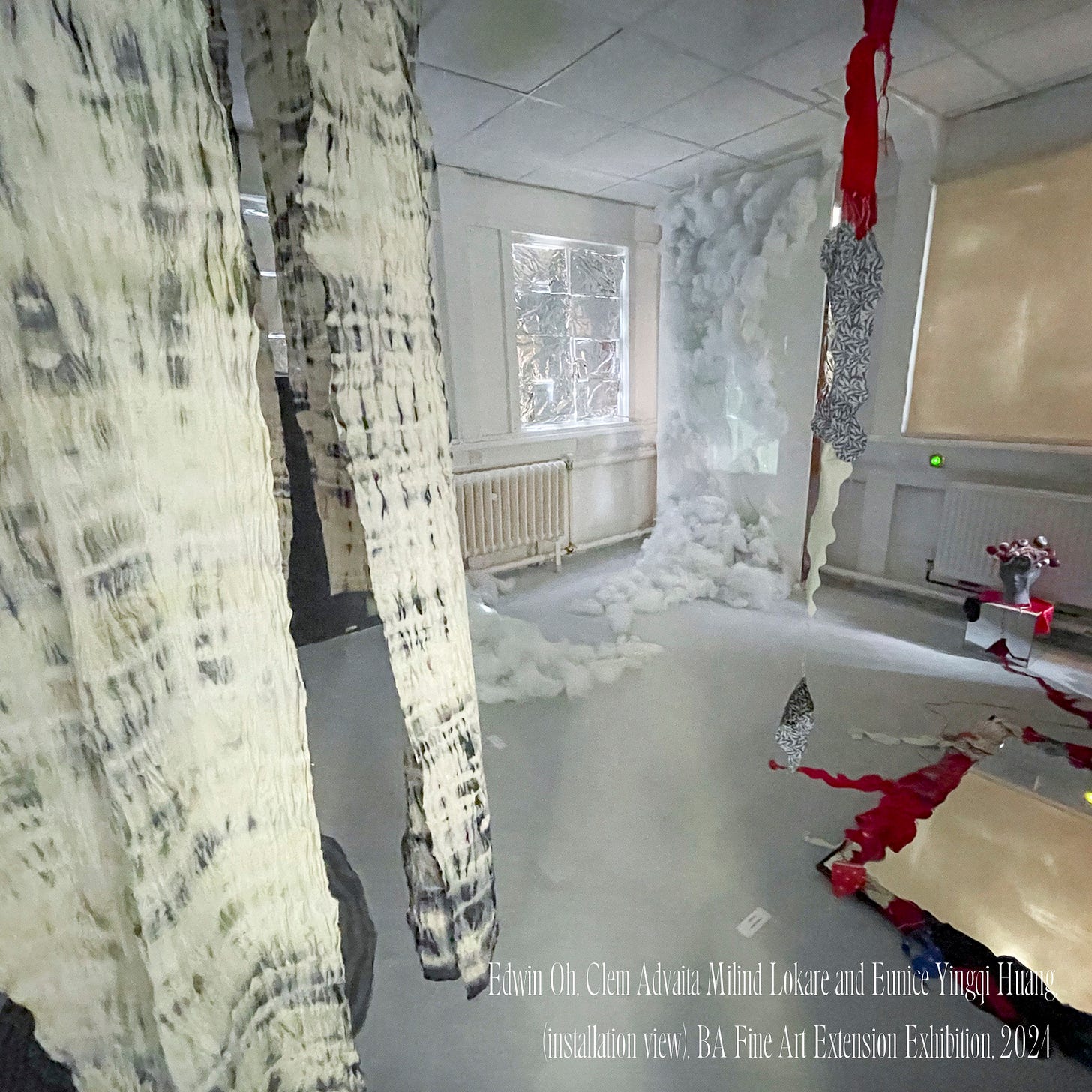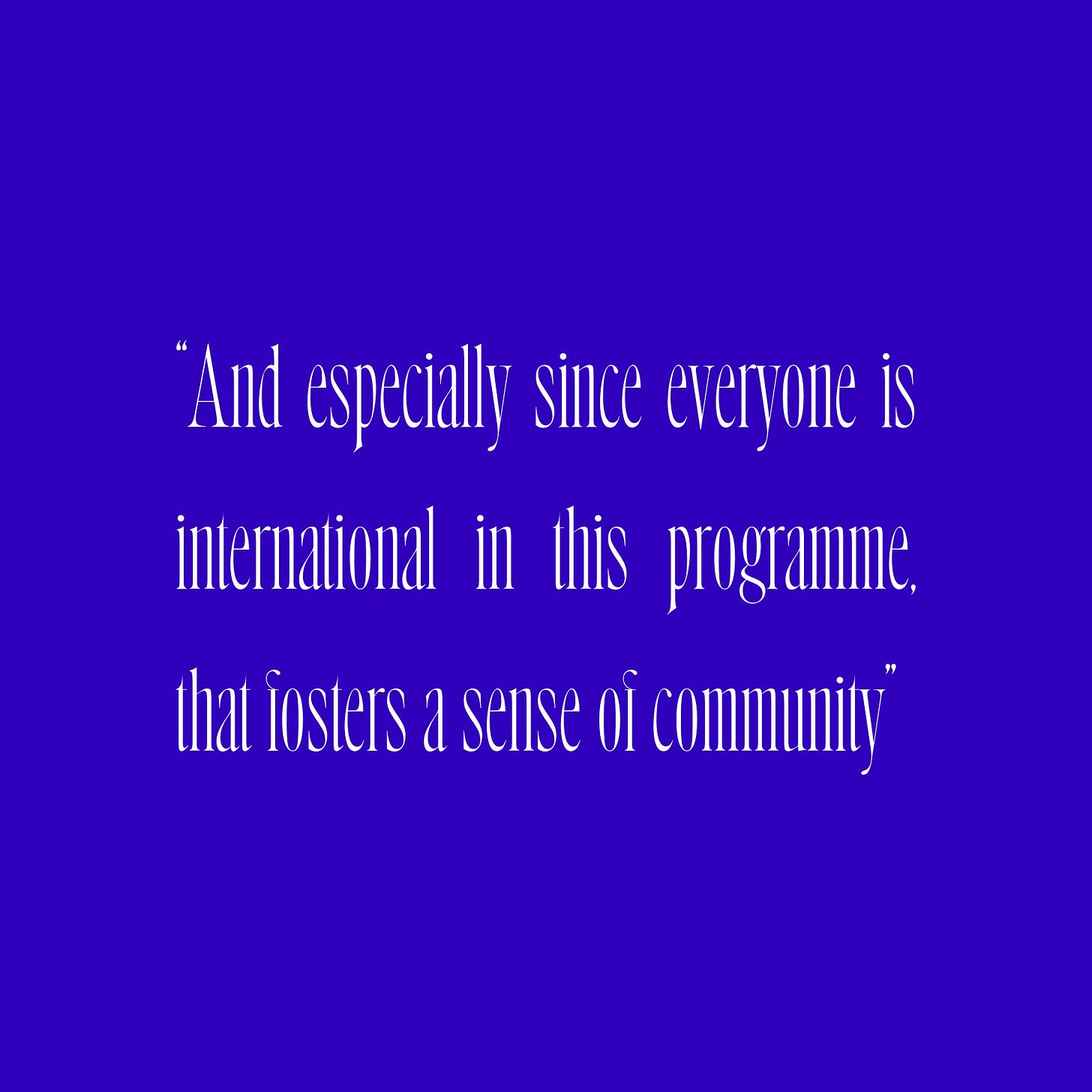Fine Art Staff Interviews - Sophie and Jackie
In our next staff interview, Xuan speaks with Jackie, Programme Leader and Director of Studio Practice for BA Fine Art Extension, and Sophie, Director of Critical Studies for BA Fine Art Extension (and studio tutor on the BA Fine Art and History of Art).
The Extension Programme is designed specifically for students from countries outside the United Kingdom at a similar level to a Foundation course but with the teaching style of the Goldsmiths BA Fine Art and Fine Art and History of Art courses, whose aim is to help students acclimatise to the art world in the UK, and to learn independently as an artist, to generate and develop their own ideas. Students move on after a year to the BA Fine Art programmes.
Jackie and Sophie, BA Fine Art Extension Degree Shows, 2024
Xuan
Could you introduce yourselves and the programme?
Jackie
I’m Programme Leader for Extension and Director for Studio Practice. 50% of the programme is studio practice, which is taught through individual and small group teaching, with more formal presentations throughout the year in different parts of the year. We also have visiting artists come in and give talks on their work and work with students throughout the year. We teach from October all the way through to mid-June, and students do an end of year exhibition along with the Degree Show students.
Sophie
I’m Director of Critical Studies and I'm responsible for Critical Studies and Portfolio of Art Writing. Critical Studies introduces students to current artistic and theoretical debates and critical vocabulary, to help situate students in contemporary art practice, both in London and within their existing international environments, and to allow them to talk eloquently about their own work and the work of their contemporaries. Portfolio of Art Writing (PAW) is the other module that students take if their English language is above a certain proficiency. In PAW, students have the opportunity to develop their creative writing, to really treat writing as an art practice. Throughout the year, we read literary pieces of writing and text-based experiments by artists, and inspired by the readings and discussions, students then develop a portfolio of writing under the guidance of their tutor and in conversation with their peers. There’s also another module for English support that you do instead of PAW if your English is below a certain level that helps you acclimatise to academic writing in the UK. This is done through CALL, the Centre for Academic Language and Literacies.
Even though the Extension programme is foundation level, it is very unlike a traditional foundation course, instead it echoes the structure you have in our BAs; it’s basically an extra year of Goldsmiths art education. Students are really encouraged to become independent practising artists and to think and work independently. And on that note, I think Critical Studies is very helpful in that it provides students with the necessary contextual knowledge of contemporary cultural work and “the art world” and gets them to understand that they're not making work in a vacuum, but in a kind of larger ecosystem of other practices and encourages them to look at other art and other disciplines, learn how to talk about other artist’ practices, but also their own, to find the right kind of vocabulary, go to shows, develop a discourse around their practice.
Jackie
The important thing is that it is about developing a professional approach to your practice, that you work independently and experimentally in the studio. We don’t set projects because we believe students need to be in working independently to be able to develop their practice, it’s a very student centred, unique learning environment, which is very different to other programmes at this level, in that it supports students who have decided on Fine Art and that they want to develop their practice towards becoming a professional artist. It can be initially quite a difficult programme in the beginning because it is a big learning curve of coming from quite a possibly structured academic environment to one which is centred around independent learners.
Sophie
It also relies on students to sort of follow their interests and take the initiative, go to the Art Practice Areas to conduct their own research, with the help of APA tutors who are specialists and who help students develop their work in terms of materials and techniques. What is really exciting is that the programme also brings together people from all kinds of countries with different cultural experiences, so it's a really rich environment to learn from one other. There’s no unified knowledge structure, it's very much about discovering and celebrating that diversity and multiplicity and what the students themselves bring to the table. It does also determine how we approach things in discussions, it’s very central to the programme.
Jackie
As a department, we are very strong now, we have a new joint research centre which Sophie’s been working on…
Sophie
Yes, there is a new Centre for Art and Ecology, led by Ros Gray and Anna Colin, and a special art research garden, and there is an allotment as well, which the Department’s been activating more over the last year! That Centre for Art & Ecology is great because it is very much about collaborations within and beyond Goldsmiths, and collaborations with the environment, with non-human agents! This collaborative research brings together different departments and disciplines, but it’s spearheaded by the Art Department, by our staff and students.
Jackie
We'll have a new ceramics APA as well, our Goldsmiths Centre of Contemporary Art which has an international programme of exhibitions, during term time we have Contemporary Art Talks every week by international and London-based artists who will come and talk about their work. It’s an opportunity for Extension students to meet other students, and also the wonderful Junior fellows who are graduates of the programme, who help, enable Extension students to interact with the Undergraduate students and facilitate a kind of cross-cultural exchange, through various events that are organised. We’re going to be developing those further and making it more structured in coming years, so these events help to further integrate various year groups.
Xuan
How have your own experiences teaching on the programme been like?
Jackie
You're talking about 20 years for me, so yeah I have to summarise! But yes I must admit that what I enjoy most about teaching here are the students and what they bring and seeing the transformation of where they are when we interviewed them, when they arrive, to when they get to this point of the year when they’ve had their show. I just find it’s an incredible kind of development, they grow in confidence, and they grow in knowledge of themselves, and what they want to be as artists. I find that the most inspiring bit of the job, and then all the other stuff is just to enable that to happen within an institution, but the main bit is them developing as artists and people and that's extraordinary.
Sophie
I absolutely love it when I talk to students and share a particular concept or artist with them, or contextualise some ideas for them and I see their mind fizzing, and you see the sparks flying, and you can just sense that suddenly something has tangibly shifted for them. That's really transformative. For them but also for me! And I think that's an incredible teaching moment when you see that happening, and I’d say that’s also why I love teaching. I think it's fantastic to discover students’ strengths, supporting them and challenging them further to develop their work, finding the right materials or resources to suggest to them, and then seeing them run with an idea, and even explode it!
Jackie
This very short period of time actually, the Extension, is there to enable students to progress onto either BA Fine Art or BA Fine Art and History of Art undergraduate degree, in terms of developing their skills in work, experimentation, independent practice, confidence, in speaking.
Sophie
For Portfolio of Art Writing, I’d like to emphasise that it is very unique, there isn’t any other programme that offers something like this at this level or even undergrad level. It's more common at master’s level, but to offer that approach to writing as an art practice just when you start your university journey is really incredible. Students really take up that challenge, that opportunity, and the work they produce is incredibly sophisticated, adventurous, and innovative. The kind of originality that you see in the forms that the writing takes is really impressive and experimental.
Xuan
That's interesting, because I think language might play a huge part in that, like if they’re multilingual, or come from really different language backgrounds, it manifests in very evocative ways.
Jackie
Yes, that’s been developed a lot especially recently, it's been a lot of looking at translation, how language operates, both visually and through writing, it’s a really important element of the programme, all of the interconnected elements of the programme, this really defines the programme actually.
Sophie
I love that, I could talk about this forever, you’re spot on to highlight the fact that the students are almost always bilingual, or trilingual. And I think that teaches you something about the fluidity of language and gives you a kind of playfulness because you realise that language is not static, it’s not rigid. It can be morphed and moulded.
Jackie
Yeah, yeah, absolutely! The same would go for Studio Practice in terms of cultural influences, how that brings with it the possibility for that same kind of transformation to happen. The art world is driven by this sort of international nature, the kind of influences that that are brought to it, we see that in the students that come on the programme and they do transform what happens on the degree, even up till they do their final degree shows. You know I've been teaching here for… 26 years!
Sophie
Oh my god Jackie! That’s a long time, you should get a prize or something.
Jackie
Yeah certainly, I should, a long service award! … Haha! But essentially I started on the BA Fine Art teaching as a Visiting Associate Lecturer. I did that for two years before my post started on the BA Fine Art programme, where I taught for many years, and then took on the Extension Programme, which at that time had 10 students, one of which I’m still in touch with.
Sophie
This is such a testament to Jackie -- that it’s grown to be such an internationally recognised programme and now we have between 50 and 70 people taking it every year.
Xuan
Yeah it’s really all Jackie!
Jackie
Yeah that student, he’s in Seoul, he runs a programme that in Seoul that feeds into this programme now! And then lots of people, lots from all over the world… There are graduates from here who, when we do the interviews, we are speaking to the applicant and they say, my tutor he studied here and was taught under you, and so we kind of see that how they spread out and influence in other ways. They bring stuff to us, and then they take what they learn and what they've taught us as well, and they take that out into the world, so it's really nice to see that kind of circular thing.
You can see they are very positive influences to the world around them, and they teach us all that as well, it’s a very mutual sort of learning. All the staff and other students engage in lots of different things that are happening all over the world.
Xuan
Is there a big difference teaching on the Extension versus on the BA programmes? Since Jackie you’ve taught on the single honours, and Sophie currently also teaches on joint honours.
Jackie
Yeah, there is there is a difference. We see the biggest kind of impact on students in terms of their learning process; the transformation from where they are beginning the year to where they end up at the end is huge. I think when they go on to the first, second, and third years, they then have a similar journey where they're kind of you know, first and second year, one or the other, will end up you know, being a positive year and not so positive here and then hopefully, you know, things will move so that the third year becomes the final, best year for them. But that process of development is longer and it's more complex in a way. But there’s not really much of a difference in the way that we approach the teaching.
The students’ abilities to understand their practice brings with it more complex conversations as they go through the years, but most of them arrive with an already complex understanding of it that morphs as they learn new things in this environment. We do look after the students more on the Extension probably a bit more than on the BA where they’re expected to be a lot more independent, especially since this is a new space for them, they have to rethink a lot of things in very different contexts.
Sophie
I see the students every week, or twice a week, you know, for Critical Studies and Portfolio of Art Writing, so there's actually a lot of contact. This is also usually because they are quite young or early in their artistic career. I mean, most of them are fresh out of high school, maybe some of them have taken a gap year, but they're still very much being shaped, so I think with that comes a lot of responsibility for us as tutors. I feel like we are really setting them up for their learning journey inside and outside university. And that’s exciting and we also take this very seriously, because we want them to feel that learning is very meaningful and fun, and a long, never-ending process.
Jackie
We also do get also get mature students, some who have even done degrees already in other subjects, and for them, it's a different kind of journey they're on, where perhaps they’re unlearning certain things to think about their work in a different way. We do have a very mixed kind of cohort at times, but the majority are younger students coming straight from educational establishments elsewhere in the world. Everyone has had very different experiences of education prior to here. So it doesn't appear to be structured, but we actually do have a very structured curriculum and support for the students. But what we're doing is wanting them not to be so aware of that so that they can actually sort of move through that and have the freedom to cultivate themselves independently, to develop things how they want to, we want them to have that autonomy. It’s a way of enabling someone to develop, rather than simply showing them which direction to go in, enabling them to discover things for themselves, and that's really important, it pushes for a lot of growth.
Sophie
If a student wants more hands-on feedback, in Critical Studies and Portfolio of Art Writing, they will get that in terms of very detailed writing advice, whether it’s overarching structural comments, or sometimes they just need someone to say, “Actually this sentence doesn't make sense,” or “What if you reformulate this passage in this way, or what if you use a different word or you push yourself and try a different writing style, or an entirely new form…” I try to get them to think outside the box, challenge them to move outside their comfort zone.
Jackie
Yes, so that’s very important about the feedback you get on the programme, because the programme offers feedback in all the different ways. And for Studio Practice you also get feedback during group sessions, individual sessions, presentations… It’s about offering feedback to individuals that will not only come from tutors, but it will also come from other students. So students start to understand how to engage in actively feeding back to their peer group and the discussions we have are the moments where feedback happens, not just in written reports or progress report forms- it's about the discussions we have, and that’s where we want to build the confidence in students, to voice their opinions and to offer feedback to others and also consider feedback themselves on their work. This provides a really important foundation for their time on the BA programmes so that they know how to receive and give feedback in bigger, more independent settings.








